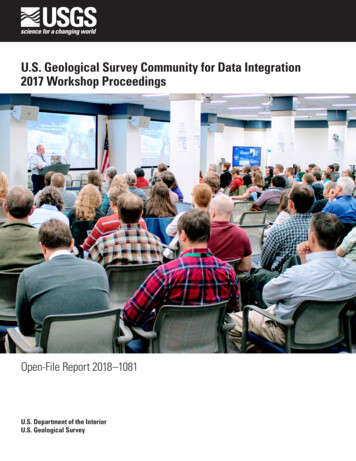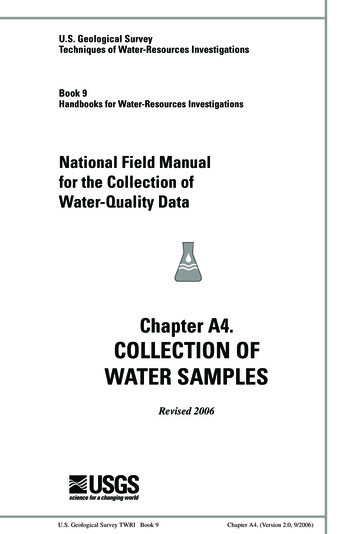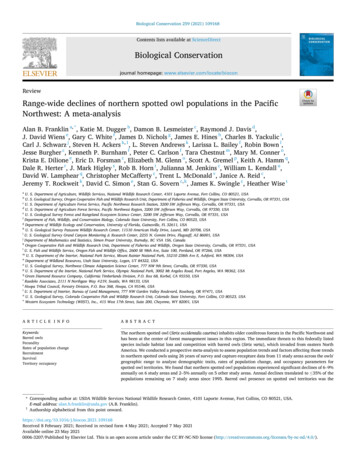
Transcription
U.S. Geological Survey Community for Data Integration2017 Workshop ProceedingsOpen-File Report 2018–1081U.S. Department of the InteriorU.S. Geological Survey
U.S. Geological Survey Community for DataIntegration 2017 Workshop ProceedingsBy Leslie Hsu, Vivian B. Hutchison, Madison L. Langseth, and Benjamin WheelerOpen-File Report 2018–1081U.S. Department of the InteriorU.S. Geological Survey
U.S. Department of the InteriorRYAN K. ZINKE, SecretaryU.S. Geological SurveyJames F. Reilly II, DirectorU.S. Geological Survey, Reston, Virginia: 2018For more information on the USGS—the Federal source for science about the Earth, its natural and livingresources, natural hazards, and the environment—visit https://www.usgs.gov or call 1–888–ASK–USGS.For an overview of USGS information products, including maps, imagery, and publications,visit https://store.usgs.gov.Any use of trade, firm, or product names is for descriptive purposes only and does not imply endorsement by theU.S. Government.Although this information product, for the most part, is in the public domain, it also may contain copyrighted materialsas noted in the text. Permission to reproduce copyrighted items must be secured from the copyright owner.Suggested citation:Hsu, L., Hutchison, V.B., Langseth, M.L., and Wheeler, B., 2018, U.S. Geological Survey Community forData Integration 2017 Workshop Proceedings: U.S. Geological Survey Open-File Report 2018–1081, 56 p.,https://doi.org/10.3133/ofr20181081.ISSN 2331-1258 (online)
iiiContentsExecutive Summary.1Introduction.1Agenda.3Roadmap Discussions on Enabling Integrated Science.6Data and Data Integration.7Where Are We Now?.7Where Do We Want to Be?.7Recommendations.7Modeling.8Where Are We Now?.8Where Do We Want to Be?.8Recommendations.8Computing Capacity.9Where Are We Now?.9Where Do We Want to Be?.9Recommendations.10Enterprise Needs.10Training, Outreach, and Education.10Computing Resources.10Science Data Infrastructure.11Where Are We Now?.11Where Do We Want to Be?.11Recommendations.11User Needs and Experience.12Where Are We Now?.12Where Do We Want to Be?.12Recommendations.12Recommended Pilot Projects.12Summary of Roadmap Discussions on Enabling Integrated Science.13Presentations and Panels.14Welcome and Opening Remarks.14Why Enable Integrated Science?.14Beyond the Fourth Paradigm—Integrative Science Is Also about People.14The Joy of Data Lightning Panel.14Data Sharing—Agreements and Processes.14Data Science Community of Practice.15Improving the Interface and User Experience for the Data Management TrainingClearinghouse.15Advanced Scientific Computing Solutions.15Strategies for Building an Integrated Science Capacity.15Panel on the Community for Data Integration’s Role in Enabling Integrated Science.16API Plugfest Report Out.17Elevation and Hydrography Data Integration.17Keynote Talk.17
ivPanel on Community for Data Integration in Action.18A Road Map for Enabling Integrated Science—The U.S. Geological Survey HasExperience with This!.18Topical Sessions.19Information Technology Architecture to Support Integrated Science .19National Map Corps Mapathon.20Legacy Data—Challenges and Solutions.20Data Citation—What’s All the Fuss?.20Data-Management Plans and Strategies for Science Centers.21Software Showcase.21Enterprise Tools for Documentation of Protocols, Methods, and Study Designs.22Getting Your Hands Dirty with 3D Elevation Program Data.23U.S. Geological Survey “Science on a Screen” for Parks, Schools, and Museums.24Delivery of Real-Time Information.24Trusted Digital Repositories—What Are They and How Do You Become One?.26Fine-Tuning Guidelines for Revising Public U.S. Geological Survey Data.26National Geospatial Data Development.27Learn More about Cloud Hosting Solutions (CHS).27Working Group Meetings.28Data Management Working Group.28Earth Science Themes Working Group.30Semantic Web Working Group.30Tech Stack Working Group.31Selected Birds of a Feather Discussion.32Data Science Community of Practice.32Open Lab.32Metadata Reviewers Community of Practice.32Trainings.33R Workshop for Beginners.33Introduction to Advanced Scientific Computing.33DataBlast.34U.S. Geological Survey Coastal and Marine Geology Data Catalog—A Demonstration of thePrototype for the U.S. Geological Survey Community for Data Integration.34Being Charlotte—Weaving Together Information Assets at the Great LakesScience Center.35Automating the Use of Citizen Scientists’ Biodiversity Surveys in iNaturalist to FacilitateEarly Detection of Species’ Responses to Climate Change.35Alaska Data Integration Working Group Metadata Toolkit—International Organization forStandards Metadata Editor.36Team Metadata Creation for Longitudinal Data—Case Study with the Great Lake ScienceCenter Research Vessel Catch Database.36Flocks of a Feather Dock Together—Using Docker and HTCondor to Link High-ThroughputComputing Across the U.S. Geological Survey.36U.S. Geological Survey Data at Risk—Expanding Legacy Data Inventory and PreservationStrategies.37Trusted Digital Repositories—What Are They and How Do You Become One?.37Data-First Architecture.37
vCrustal Geophysics and Geochemistry Science Center and Central Mineral andEnvironmental Resources Science Center Field Collection with ArcGIS OnlineTools—Collector and Survey123.37Software Release Guidelines.38Presenting Complex Analytical Datasets to the Public with Accessible Cloud-BasedVisualizations.38Improving the Data Management Training Clearinghouse.38ScienceBase as a Platform for Data Release.39An Information Ecosystem to Meet the Data-Management Requirements of the Long-TermAgrocecosystem Research Network.39U.S. Geological Survey StreamStats—Hydrologic and Geospatial Data Integrated toSupport Water Science and Management.39The Coastal and Marine Ecological Classification Standard, a Common Language ThatFacilitates Integrating Data About Marine Ecosystems.40Fundamental Science Practice Advisory Committee Scientific Data GuidanceSubcommittee.40The Benefits of Microservice Architectures.40A Technique for Converting Time-Series Network Common Data Form (NetCDF) Files to aDifferent Convention and Two Options for Discovery and Display.41Web Map Application for a Historical Geologic Field Photo Collection.41An Enterprise-Level Problem—Big Data, Small Science Staff.41Visualizing Community Exposure and Evacuation Potential to Tsunami Hazards Using anInteractive Tableau Dashboard.42Developing Application Programming Interfaces to Support Enterprise-LevelMonitoring Using Existing Tools.42An Interactive Web-Based Application for Earthquake-Triggered Ground-FailureInventories.42Secondary Validation of Geospatial Metadata.43How Can Cloud Hosting Solutions Help You?.43A Framework for Managing, Sharing, and Visualizing Land-Use Scenario Data.43Dynamic Workflows to Advance Data Interoperability.43U.S. Geological Survey Near Real-Time Significant Earthquake and Earthquake ScenarioGeographic Information System Feeds.44Second Generation Metadata Wizard.44Bridging the Gap Between Water and Elevation—A U.S. Geological Survey Pilot Project.44A Semantic Architecture for Multidisciplinary Modeling.45Extending ScienceCache to Accommodate Broader Use within the U.S. GeologicalSurvey—Project Overview.45Evaluation and Testing of Standardized Forest Vegetation Metrics Derived from LightDetection and Ranging (Lidar) Data—Informing Geospatial Data Products for 3DElevation Program, LANDFIRE, and the National Park Service Vegetation InventoryPrograms.45Core Science Analytics, Synthesis, and Library—Facilitating Lifecycle Management of U.S.Geological Survey Data and Information Assets.46Summary of Workshop Outcomes.46Acknowledgments.47References.47Appendix 1. Interactive Session Questions and Comments.48
viThemes from the Submissions .48List of Pilot Projects from sli.do .48Recommendation Polls from Roadmap Discussions on Enabling Integrated Science .48Appendix 2. Attendees.51Appendix 3. Community for Data Integration Science Support Framework .56Figures1. Visualization of the five themes, as road signs, discussed in the breakout sessions ofthe Roadmap Discussions on Enabling Integrated Science .62. The U.S. Geological Survey Integrated Decision Support System (pyramid) diagrampresented and discussed by Kevin Gallagher during his plenary session .253. The Community for Data Integration Science Support Framework .56Tables1. Ideas for pilot projects that came out of the plenary session on the last day of theconference.492. Recommendations under the Data and Data Integration category .493. Recommendations under the Modeling category.504. Recommendations under the Computing Capacity—Training, Outreach,and Education category.505. Recommendations under the Science Data Infrastructure category .506. List of conference attendees .51Conversion FactorsInternational System of Units to U.S. customary unitsMultiplyByTo obtainLengthkilometer (km)0.6214mile (mi)kilometer (km)0.5400mile, nautical (nmi)Abbreviations3DEP3D Elevation ProgramACCAdvanced Computing CooperativeAPIapplication programming interfaceappapplicationBAOBureau Approving OfficialCComputing Capacity
viiCDICommunity for Data IntegrationCFclimate and forecastCHSCloud Hosting SolutionsCMECSCoastal and Marine Ecological Classification StandardCMGPCoastal Marine Geology ProgramCOSSACouncil of Senior Science AdvisorsCSDMSCommunity Surface Dynamics Modeling SystemCSWCatalog Services for the WebDData and Data IntegrationDevOpssoftware development and information technology operationsDMPdata-management planDMZdemilitarized zone (computing)DMWGData Management Working GroupDOIDigital Object IdentifierDYFIDid You Feel It?EarthMAPEarth Monitoring, Analyses, and ProjectionsEPICEquatorial Pacific Information CollectionERDDAPEnvironmental Research Division’s Data Access ProgramEROSEarth Resources Observation and ScienceESIPEarth Science Information PartnersFGDCFederal Geographic Data CommitteeFORCE11Future of Research Communications and e-ScholarshipFSPACFundamental Science Practices Advisory CommitteeGEOGroup on Earth ObservationsGISgeographic information systemGLSCGreat Lakes Science CenterGRACEnetGreenhouse gas Reduction through Agricultural Carbon Enhancement NetworkHTChigh-throughput computingHPChigh-performance computingICEMMInteragency Collaborative for Environmental Modeling and MonitoringIPDSInformation Products Delivery SystemISOInternational Organization for StandardsLUCASLand-Use and Carbon Scenario SimulatorMModelingMOOCmassive open online course
viiiMPIMessage Passing InterfaceNABatNorth American Bat Monitoring ProgramNetCDFNetwork Common Data FormNGPNational Geospatial ProgramNHDNational Hydrography DatasetNHDPlusNational Hydrography Dataset PlusNOAANational Oceanographic and Atmospheric AdministrationNPSNational Park ServiceOEIOffice of Enterprise InformationOPeNDAPOpen-source Project for a Network Data Access ProtocolORCIDOpen Researcher and Contributor IDPRecommended Pilot ProjectsRESTrepresentational state transferRGEResearch Grade EvaluationRVCATResearch Vessel CatchSScience Data InfrastructureSCSDWGScience Center Strategy Development Working GroupSDCScience Data CatalogSTEWARDSSustaining the Earth’s Watersheds, Agricultural Research Data SystemTHREDDSThematic Real-Time Environmental Distributed Data ServicesUUser Needs and ExperienceUMESCUpper Midwest Environmental Sciences CenterUSGSU.S. Geological SurveyW3C PROVWorld Wide Web Consortium provenance standardsWMSweb mapping servicesWRETWeb Re-Engineering TeamXMLExtensible Markup Language
U.S. Geological Survey Community for Data Integration2017 Workshop ProceedingsBy Leslie Hsu, Vivian B. Hutchison, Madison L. Langseth, Benjamin WheelerExecutive SummaryThe U.S. Geological Survey (USGS) Community for Data Integration (CDI) Workshop was held May 16–19, 2017 at theDenver Federal Center. There were 183 in-person attendees and 35 virtual attendees over four days. The theme of the workshopwas “Enabling Integrated Science,” with the purpose of bringing together the community to discuss current topics, shared challenges,and steps forward to advance integrated science at the USGS.The CDI welcomed several keynote speakers, including Bill Werkheiser, USGS Acting Director; Kevin T. Gallagher,USGS Associate Director of the Core Science Systems Mission Area; Bruce Caron, Earth Science Information PartnersCommunity Architect; and Tim Quinn, Chief of the USGS Office of Enterprise Information. Their presentations focused onthe importance of collaborative, cross-disciplinary, and open science and the role of the CDI in identifying and supporting newopportunities in these areas for the USGS and its partners.In addition to the stated theme, the workshop agenda was driven by the needs of the CDI, with topics highlighting current resources and technologies that could help attendees in their daily work. Topical sessions were proposed by CDI membersand included subjects such as data citation, information technology architecture, legacy data, real-time data, and many more.Plenary speakers from the community talked about USGS activities in data science, elevation and hydrography data integration,advanced scientific computing solutions, cloud computing, data-management training, and data-sharing agreements. Two panelsaddressed the role of the CDI in enabling integrated science and examples of CDI-supported projects in action.Breakout discussions focused on the workshop theme of “Enabling Integrated Science” and covered five topics: Data andData Integration, Modeling, Computing Capacity, Science Data Integration, and User Needs and Experience. Sessions on eachtopic identified actions that could bring the USGS and the broader Earth science community closer to the goal of makingintegrated science commonplace. The breakouts produced recommendations with the broad themes of improving communicationand connections across the USGS, reducing duplication and increasing knowledge transfer, increasing training and testbedopportunities to learn and experiment, and creating community-supported standards to enable better integration and interoperability.The DataBlast poster and live demonstration session showcased 36 projects from around the CDI and included recentCDI-funded projects as well as other USGS and partner initiatives that were related to data and software integration and discovery.Importantly, the CDI workshop provided a forum for scientists, technologists, data and resource managers, program managers,and others to convene face to face to discuss common methods, interests, challenges, and solutions related to scientific data andtechnologies. As a result of this rare convergence, new connections were made across disciplines, backgrounds, and geographicallocations, seeding future activities and collaborations. Sharing of ideas from all attendees was encouraged through the use of amobile application to collect real-time questions and feedback from the audience.The primary outcomes of the workshop are the recommendations from the breakout sessions titled “Roadmap Discussionson Enabling Integrated Science” and from the topical sessions detailed in these proceedings. These sessions, as well as theplenary discussions, identified new areas of collaboration and learning that the CDI will facilitate, such as data science, softwaredevelopment, scientific modeling practices, and user needs and experience. The CDI will build on the results of the workshop toguide its future topics, events, and funding opportunities to support an integrated science capacity for the USGS.IntroductionThe U.S. Geological Survey (USGS) Community for Data Integration (CDI) is a dynamic community of practice with thegoal of advancing data and information integration and accelerating Earth science research. As a community of practice, theCDI’s purpose is to build a community of people to learn together and increase knowledge and skills that they care about. This
2 U.S. Geological Survey Community for Data Integration 2017 Workshop Proceedingsknowledge and skills building results in community members doing their jobs better and sharing their successes across theUSGS. Through partnerships, working groups, funded projects, meetings, and trainings, the CDI enables the development ofcollaborative tools and best practices in support of data integration and management, cyberinfrastructure, and data visualization.Guiding principles for CDI projects and activities are to focus on targeted efforts that yield near-term benefits to science, while laying groundwork for future efforts; leverage existing capabilities and data; implement and demonstrate innovative solutions that could be used or replicated by others at scales from projectto enterprise; preserve, expose, and improve access to Earth science data, models, and other outputs; and develop, organize, and share knowledge and best practices in data integration.The goals of CDI in-person workshops, which are held approximately every two years, are to identify new, high-valueopportunities for advancing data integration in the Earth sciences, share successes in data integration, applications, and tools,and provide training based on community needs. In 2017, the CDI Workshop was held May 16–19 at the Denver Federal Center.There were 183 in-person attendees and 35 virtual attendees over the four days of the workshop (appendix 2). The theme of the2017 workshop was “Enabling Integrated Science.”The workshop year marked the end of the USGS science strategy for 2007–2017 (U.S. Geological Survey, 2007). Althougha new strategic plan has not been released, the recent report of the USGS Council of Senior Science Advisors (COSSA), entitled“Grand Challenges for Integrated U.S. Geological Survey Science—A Workshop Report” (Jenni and others, 2017), provides apreview. Both the old strategic plan and new COSSA report stress the importance of interdisciplinary approaches to address thecomplex scientific issues facing the nation. It is in this context that the CDI was asked to focus its 2017 workshop on “EnablingIntegrated Science”—meaning, more specifically, to lay the groundwork for an integrated decision-support system that can beapplied to the variety of complex problems within the purview of the USGS.To address this theme, the CDI coordinators included in the workshop agenda a recurring breakout session entitled “RoadmapDiscussions on Enabling Integrated Science”— the goal being to encourage as much participation as possible among the workshopattendees (a shifting cast of characters from one day to the next, providing a wide range of perspectives). In addition, the plenarypresentations by Tim Quinn, Marty Goldhaber, Bruce Caron, Kevin Gallagher, Bill Werkheiser, and Viv Hutchison all touched onthe theme of integrated scien
U.S. Geological Survey Community for Data Integration . 2017 Workshop Proceedings. U.S. Geological Survey Community for Data . Integration 2017 Workshop Proceedings. By Leslie Hsu, Vivian B. Hutchison, Madison L. Langseth, and Benjamin Wheeler . Recommendations under the Modeling category . 50 4. Recommendations under the Computing .










